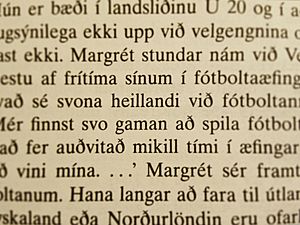Acute accent facts for kids
|
´
Acute accent |
||||||||||||||||||||||||||||||||||||||||||||||||||||
|---|---|---|---|---|---|---|---|---|---|---|---|---|---|---|---|---|---|---|---|---|---|---|---|---|---|---|---|---|---|---|---|---|---|---|---|---|---|---|---|---|---|---|---|---|---|---|---|---|---|---|---|---|
|
||||||||||||||||||||||||||||||||||||||||||||||||||||
|
|
||||||||||||||||||||||||||||||||||||||||||||||||||||
| Á | á |
| Ấ | ấ |
| Ắ | ắ |
| Ǻ | ǻ |
| Ǽ | ǽ |
| Ć | ć |
| Ḉ | ḉ |
| É | é |
| Ế | ế |
| Ḗ | ḗ |
| Ǵ | ǵ |
| Í | í |
| Ḯ | ḯ |
| Ḱ | ḱ |
| Ĺ | ĺ |
| Ḿ | ḿ |
| Ń | ń |
| Ó | ó |
| Ố | ố |
| Ṍ | ṍ |
| Ṓ | ṓ |
| Ǿ | ǿ |
| Ṕ | ṕ |
| Ŕ | ŕ |
| Ś | ś |
| Ṥ | ṥ |
| Ú | ú |
| Ǘ | ǘ |
| Ứ | ứ |
| Ṹ | ṹ |
| Ẃ | ẃ |
| Ý | ý |
| Ź | ź |
| Ѓ | ѓ |
| Ќ | ќ |
The acute accent ( ´ ) is a small mark you often see above letters in many written languages. It's usually placed over a vowel (like a, e, i, o, u) to show you how to say it. Sometimes, it can also be found on consonants. This accent can change the sound of a word or even show which part of a word should be stressed. The acute accent is used in many modern languages that use Latin, Cyrillic, and Greek alphabets. It is one of many similar marks called diacritics.
Contents
History of the Acute Accent
The acute accent was first used in Ancient Greece. It helped speakers know when to say a syllable with a higher pitch in their voice. Another early accent mark was the apex. In Latin, the apex was used to show long vowels.
How the Acute Accent is Used
Changing Sounds with the Acute Accent
The acute accent is mostly used to tell readers about the sound of vowels in words. Sometimes, it's very important because it can change the meaning of two words that look similar. For example, resume might mean to start again, but résumé is a summary of someone's work and school experience.
Different languages use the acute accent in slightly different ways. It might show:
- that the vowel is stressed, meaning you say it with more emphasis;
- the vowel height of some stressed vowels in many Romance languages (like French or Spanish);
- long vowels, meaning you hold the vowel sound longer;
- the tone in languages such as Vietnamese or Mandarin Chinese when written in pinyin;
- or, the pitch, or high accent, in dictionaries or language learning textbooks.
Creating New Letters with Accents
Some languages use the acute accent to actually create new letters in their alphabet. For example, both Faroese and Icelandic add the acute accent to all of their vowels. This creates new letters like á, í, ó, ú, and ý (plus é in Icelandic). These are seen as separate letters with their own unique sounds. In Turkmen, the letter Ý is a consonant.
French Words in Other Languages
Many languages have borrowed words from French. When these words are used in other languages, they often keep their acute accent. For example, many Norwegian words that came from French still have an acute accent. Some examples are: allé, kafé, idé, and komité.
In Swedish, you might see words like café and resumé (which is a noun). Even in English, we use some French words with acute accents, such as: attaché, canapé, cliché, communiqué, café, décor, fiancé, passé, toupée, and touché. However, sometimes writers in English might forget or choose not to use the accent mark.
Writing Other Languages in English
Some languages, like Arabic, Persian, or Japanese, don't use the Latin alphabet. When words from these languages are written using English letters, some writers use the acute accent to show how the words should sound. This was more common in older books, but it is less common today.
Related pages
- Circumflex accent
- Font
- Grave accent
- International Phonetic Alphabet (IPA)
- Typography
See also
 In Spanish: Acento agudo para niños
In Spanish: Acento agudo para niños


